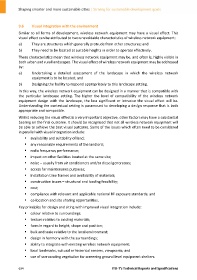Page 644 - Shaping smarter and more sustainable cities - Striving for sustainable development goals
P. 644
9.6 Visual integration with the environment
Similar to all forms of development, wireless network equipment may have a visual effect. This
visual effect can be attributed to two unavoidable characteristics of wireless network equipment:
a) They are structures which generally protrude from other structures; and
b) They need to be located at suitable heights in order to operate effectively.
These characteristics mean that wireless network equipment may be, and often is, highly visible in
both urban and rural landscapes. The visual effect of wireless network equipment may be addressed
by:
a) Undertaking a detailed assessment of the landscape in which the wireless network
equipment is to be located; and
b) Designing the facility to respond appropriately to this landscape setting.
In this way, the wireless network equipment can be designed in a manner that is compatible with
the particular landscape setting. The higher the level of compatibility of the wireless network
equipment design with the landscape, the less significant or intrusive the visual effect will be.
Understanding the contextual setting is paramount to developing a design response that is both
appropriate and compatible.
Whilst reducing the visual effect is a very important objective, other factors may have a substantial
bearing on the final outcome. It should be recognized that not all wireless network equipment will
be able to achieve the best visual outcome. Some of the issues which often need to be considered
in parallel with visual integration include:
availability and suitability of land;
any reasonable requirements of the landlord;
radio frequency performance;
impact on other facilities located at the same site;
noise – usually from air conditioners and/or diesel generators;
access for maintenance purposes;
installation time frames and availability of materials;
construction issues – structural and loading feasibility;
cost;
compliance with relevant and applicable national RF exposure standards; and
co‐location and site sharing opportunities.
Key principles for design and siting with improved visual integration include:
colour relative to surroundings;
texture relative to existing materials;
form in regard to height, shape and position;
bulk and scale relative to the local environment;
design in harmony with the surroundings;
ability to integrate with existing wireless network equipment;
local landmarks, cultural or historical centres, viewpoints; and
use of surrounding vegetation for screening ground level equipment shelters.
634 ITU‐T's Technical Reports and Specifications

